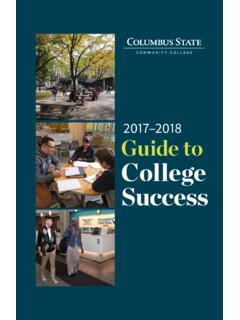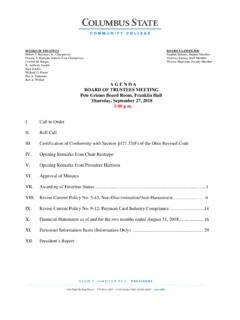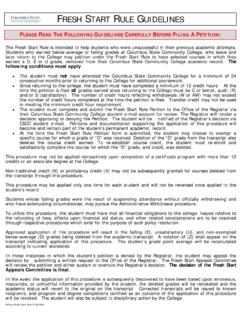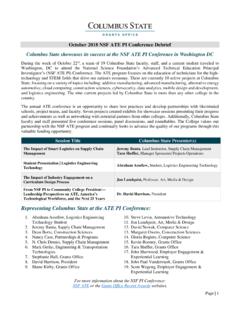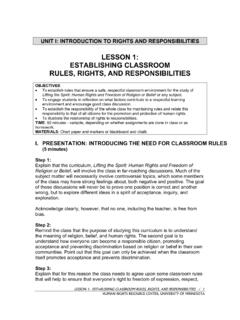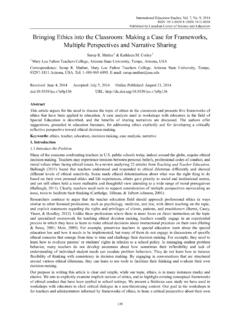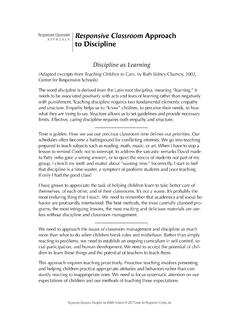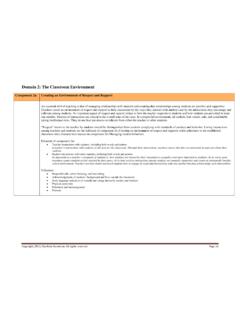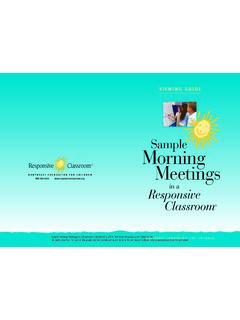Transcription of Best Practices in Classroom Management
1 Best Practicesin Classroom ManagementOctober2004 Christopher DunbarCollege of EducationMichigan State UniversityBEST PRACTICESIN Classroom MANAGEMENTC hristopher DunbarCollege of EducationMichigan State UniversityOctober 2004 Copies of this report are available from:University Outreach & EngagementMichigan State UniversityKellogg Center, Garden LevelEast Lansing, Michigan 48824 Phone: (517) 353-8977 Fax: (517) 432-9541E-mail: 2004 Michigan State University. All rightsreservedThis monograph was prepared for Lansing SchoolDistrict elementary teacher training sessions, Fall2004. The views expressed are solely those of theauthor. For more information about this report,contact Dr. Christopher Dunbar at (517) 353-9017,or email: Chapel JacksonFundingThis report was supported in part by UniversityOutreach & Engagement, Michigan State University is an affirmative-action,equal-opportunity 1 The Impact of Poverty on Student AchievementLack of Social Capital Among Poor ChildrenClassroom Arrangement Strategies.
2 3 Classroom ArrangementEstablishing rules of ConductConsequences Versus PunishmentPreventing DisruptionsPsychology of Problem Behavior .. 6 Children Behave Inappropriately for a ReasonMoving from Inappropriate to Appropriate BehaviorWhen Intervdntion is RequiredTeacher Management 9 Supporting and Encouraging Student SuccessDespite the 10 Appendix APositive Behavior Support for Young Children:Functional Assessment and Behavior Support PlanAppendix BClassroom Management Profile1 INTRODUCTIONT oday many urban schools are comprised ofchildren who have been described by the prefix dis: disenchanted, disaffected, disaffiliated, disturbedand disruptive. Many of these children live incommunity conditions that have adverselyimpacted their readiness for school. Some of theseconditions include: the family s loss of meaningfulemployment, the infestation of illegal drugs, and anincrease in single-parent households. In addition,the number of children being reared bygrandparents has increased.
3 There are also leaguesof other children who have lived in multiple fostercare facilities, and still others who have beensimply left to rear subjected to these living conditions have agreater propensity to engage in inappropriatebehavior in the Classroom . Problem behavioroccurs when a child is unable to communicateneeds or desires effectively. The behavior is acommunicative function. Typically a challengingbehavior serves to obtain something or to avoidsomething. It becomes a very effective form ofcommunication and to the child seems reasonableand behavior significantly disruptsindividual learning, social acceptance, andopportunities for inclusion into the society at challenging behavior can be dangerous andeven life researchers have argued that antisocialbehaviors in youth lead to a host of academic andsocial problems such as low self-esteem,membership in deviant groups, substance abuse,truancy, and delinquency. It is their belief that dueto the high level of social incompetence amongyouths exhibiting delinquent behaviors, theseyouths are unable to get along with others, dealwith group situations effectively, make appropriatechoices, understand others viewpoints, or dealreasonably with stressful , indeed, many of these behaviors are amanifestation of living in poverty, the question thenbecomes, To what extent does poverty affectstudent achievement?
4 The Impact of Povertyon StudentAchievementOnce a professor told our class that as a child, hehad to wash his socks every evening so that he dhave clean ones to wear to school the nextmorning. He further revealed that most of thechildren in his neighborhood did likewise. The pointis that children in his neighborhood didn t reallyknow they were poor. Everyone did the same sortsof things to make ends meet. Today, however, the haves and the have nots are much moreapparent. Children are far more aware of theirfamily s economic situation than in the consider the impact of poverty on students achievement without considering its impact onstudent behavior is putting the cart before thehorse. Most experienced teachers will tell anyonewho will listen that without some semblance oforder in the Classroom there will be no learning! Yetstudy after study focuses on poverty andachievement, without much consideration ofinappropriate student behavior as a manifestation ofliving in far back as the Coleman Report (1966) we haveknown that that a child s poverty level has anadverse effect on academic achievement.
5 However,in a study conducted by Gallagher (1998), it was2reported that to simply focus on developingstandards and raising expectations is not sufficient: We need to face the unpleasant reality thateducation by itself is a weak treatment. In supportof this conclusion, a study conducted for the of Education (1996) indicated severalimportant factors which adversely impact studentbehavior. These factors include: Urban schools had larger enrollments, onaverage, than suburban schools at both theelementary and secondary levels; Student behavior problems were more commonin urban schools than in other schools,particularly in absenteeism, Classroom discipline,weapons possession, and student pregnancy; Teacher absenteeism, an indicator of morale,was more of a problem in urban schools than inrural or suburban schools; Students in high poverty schools, regardless oflocation, were less likely to feel safe in schooland spent less time on homework than those inlow poverty schools; and Young adults who had attended urban and urbanhigh-poverty schools had much higher povertyand unemployment rates later in life than thosewho had attended other of Social CapitalAmong Poor ChildrenMany researchers, including Maeroff (1998),discuss the effects of poverty within the context ofsocial capital.
6 These authors remind us that poorchildren often are lacking in four types of socialcapital: A sense of academic initiative. Many studentslack a school work ethic, good study habits, anda high level of self-discipline. Academic successis not perceived as relevant to their future lives. A sense of knowing. Many students do not havea sturdy foundation upon which to build successin school. They do not have the opportunities tothrive, which include pre-school attendance,travel, summer camps, home computers, tutors,music lessons, organized sports, exposure to thearts, coaching for college admissions tests, andvisits to colleges. A sense of connectedness. Many students feelalienated and do not have a sense of belongingto their community, neighborhood, or school. Tobe successful in school, students must feel thatthey belong and perceive the work of schoolas having great value. Connectedness also meansthat students have good relationships with adultsin the school, the home, and the adults can be advocates for students asthey face barriers and problems in and out ofschool.
7 A sense of well-being. Poverty, concerns forone s emotional and psychological well-being,and worries about what the future holds causemany students to develop a negative sense ofwell-being. As a result, many have little sense ofhope, combined with low levels of self-confidence and Keith was asked what he wanted tobe when he grew up, he became angryand responded: I don t know! Why youasking me that? I might be dead or injail! 3 Classroom ARRANGEMENTSTRATEGIESP overty obviously impacts social capital; however,without the capacity to address abject poverty inthe lives of many of the children who sit before us,we must focus on issues that may be addressed inthe Classroom : physical arrangement andmanagement Fred Jones, a noted Classroom managementexpert, explains: A good Classroom seatingarrangement is the cheapest form of classroommanagement. It s discipline for free. Many experienced teachers recommend assignedseating for students to facilitate discipline andinstruction.
8 They argue that students left to theirown devices will always choose a seat that placesthe teacher at the greatest disadvantage. Bestpractices suggest a few common-sense rules toguide Classroom arrangements. Students should be seated where their attentionis directed toward the teacher. High traffic areas should be free fromcongestion. Students should be able to clearly see chalkboard, screens, and teacher. Students should be seated facing the front of theroom and away from the windows. Classroom arrangements should be flexible toaccommodate a variety of teaching rules ofConductMuch research on Classroom Management hasfocused on student participation in establishingcodes of conduct. It suggests that students shouldactively participate in the creation of guidelinesgoverning Classroom behavior. This belief suggeststhat students will support rules they establish. Bestpractices recommend minimizing the number ofrules. Children have a tendency to recommend alaundry list of rules .
9 Teachers, however, shouldprovide limited structural input so that rules aredirect, clear, and consistent, and encourage positivebehavior. In addition, teachers must make sure thatrules are designed to support a concept ofconsequences for inappropriate behavior ratherthan good Classroom seating arrangement is thecheapest form of Classroom Management . Fred JonesClassroom Management expert Fred Jones says teacher mobilityshould be the aim of any Classroom seating arrangement. Thisarrangement is among several different seating configurationsillustrated in Jones s book, Tools for student and replaces it with an objectiveapproach that will allow students to learn from themistake. Schools should and must be environmentswhere mistakes are made and students are providedcaring opportunities to learn from Payne, in her book A Framework forUnderstanding Poverty (2003), suggests that anyprogram which has as its intent to address discipline(inappropriate behavior) must clearly delineate theexpected behaviors and the probable consequencesof not choosing those behaviors.
10 The program mustalso emphasize that the individual always has achoice to follow or not to follow the expectedbehaviors. With each choice comes a consequence,either desirable or undesirable. When a program ofdiscipline has as its focus I tell you what to do andwhen, the child is unable to move fromdependence to independence (p. 101).Preventing DisruptionsEffectively managed classrooms are orderly(relatively speaking), with a minimum of studentmisbehavior and reasonable levels of time on Classroom managers are more skilled atpreventing disruptions from occurring in the firstplace, according to J. S. Kounin (1970). Kouninidentified specific approaches to keep studentsfocused on learning and reduce the likelihood ofclassroom disruption. These included:Consequences versusPunishmentEmerging research suggests that inappropriatebehavior should be followed by consequencesrather than punishment. Consequences are viewedas an end result of a child s inappropriate act.

